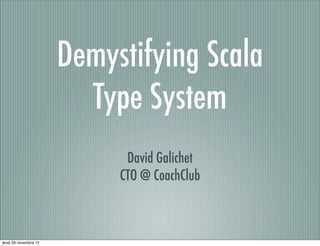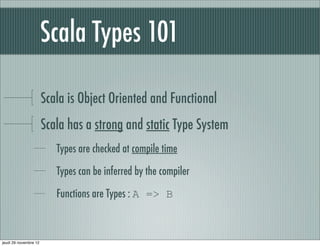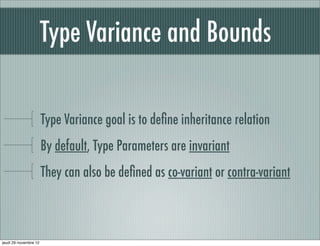This document summarizes a presentation on demystifying Scala's type system. It covers key topics like types and variance, type bounds, abstract type members, ad-hoc polymorphism, existential types, and generalized type constraints. The schedule lists these topics to be covered in the presentation.







![Scala Types 101
Types are used to define
[abstract] classes
objects
traits
jeudi 29 novembre 12](https://image.slidesharecdn.com/psug-demystifyingscalatypes-121129050333-phpapp02/85/Demystifying-Scala-Type-System-8-320.jpg)

![Scala Types 101
Scala Types can be parameterized
List[A]
Either[A, B]
Functions can also take type parameters
def show[A](a:A):String = a.toString
jeudi 29 novembre 12](https://image.slidesharecdn.com/psug-demystifyingscalatypes-121129050333-phpapp02/85/Demystifying-Scala-Type-System-10-320.jpg)

![Type Variance and Bounds
Co-Variance(M[+T]) B M[B]
if A extends B then M[A] extends M[B] A M[A]
Contra-Variance (M[-T])
if A extends B then M[B] extends M[A]
B M[A]
A M[B]
jeudi 29 novembre 12](https://image.slidesharecdn.com/psug-demystifyingscalatypes-121129050333-phpapp02/85/Demystifying-Scala-Type-System-12-320.jpg)
![Type Variance and Bounds
Some examples of Types with varying type parameters
List[+A]
Writer[-A]
Function1[-T, +R]
jeudi 29 novembre 12](https://image.slidesharecdn.com/psug-demystifyingscalatypes-121129050333-phpapp02/85/Demystifying-Scala-Type-System-13-320.jpg)
![Type Variance and Bounds
scala> class Test[+A] {
| def test(a: A): String = a.toString
| }
<console>:8: error: covariant type A occurs in
contravariant position in type A of value a
WTF ?
jeudi 29 novembre 12](https://image.slidesharecdn.com/psug-demystifyingscalatypes-121129050333-phpapp02/85/Demystifying-Scala-Type-System-14-320.jpg)
![Type Variance and Bounds
First of all, take a look at Functions :
Function1[-T,+R]
Functions are Co-Variant on return type (+R) and Contra-
Variant on parameters (-T) !
We can substitute Function1[A,D] by
Function1[B,C] : B D Function1[A, D]
⋀
A C Function1[B, C]
jeudi 29 novembre 12](https://image.slidesharecdn.com/psug-demystifyingscalatypes-121129050333-phpapp02/85/Demystifying-Scala-Type-System-15-320.jpg)
![Type Variance and Bounds
This is a Function1 instance !
class Test[+A] {
def test(a: A): String = a.toString
}
Type A should be either Invariant or Contra-Variant but it’s
Co-Variant
jeudi 29 novembre 12](https://image.slidesharecdn.com/psug-demystifyingscalatypes-121129050333-phpapp02/85/Demystifying-Scala-Type-System-16-320.jpg)
![Type Variance and Bounds
Solution : introduce a bounded Type
class Test[+A] {
def test[B >: A](b: B): String = b.toString
}
Lower Type Bound : this new Type B is a super Type of A
Method test will accept A or any super Type of A
jeudi 29 novembre 12](https://image.slidesharecdn.com/psug-demystifyingscalatypes-121129050333-phpapp02/85/Demystifying-Scala-Type-System-17-320.jpg)
![Type Variance and Bounds
Implementation of a List
trait List[+T] {
def ::[U >: T](u: U): List[U] = Cons(u,
this)
}
case class Cons[T](head: T, tail: List[T])
extends List[T]
case object Nil extends List[Nothing]
Inherit from any List[T]
jeudi 29 novembre 12](https://image.slidesharecdn.com/psug-demystifyingscalatypes-121129050333-phpapp02/85/Demystifying-Scala-Type-System-18-320.jpg)
![Type Variance and Bounds
Variance is not applicable to mutable state :
trait Mutable[+T] {
var t: T // generate a setter:
// def t_=(t: T) {this.t = t}
}
Co-Variant parameter in Contra-Variant position
⇒ A mutable List can’t be Co-Variant !
jeudi 29 novembre 12](https://image.slidesharecdn.com/psug-demystifyingscalatypes-121129050333-phpapp02/85/Demystifying-Scala-Type-System-19-320.jpg)
![Type Variance and Bounds
Implementation of a Writer - Part1
class B { def toString = "I’m B" }
class A extends B { def toString = "I’m A" }
Inherit from any List[T]
trait Writer[-T] { def write(t: T): String }
val bWriter = new Writer[B] { def write(b:
B): String = b.toString }
def write[T](t: T)(w: Writer[T]) = w.write(t)
jeudi 29 novembre 12](https://image.slidesharecdn.com/psug-demystifyingscalatypes-121129050333-phpapp02/85/Demystifying-Scala-Type-System-20-320.jpg)
![Type Variance and Bounds
Implementation of a Writer - Part2
write(new B)(bWriter)
res> String = I’m B We need a Writer[A]
write(new A)(bWriter)
res> String = I’m A
B Write[A]
Fortunately, Writer[B] extends Writer[A]:
A Write[B]
jeudi 29 novembre 12](https://image.slidesharecdn.com/psug-demystifyingscalatypes-121129050333-phpapp02/85/Demystifying-Scala-Type-System-21-320.jpg)
![Type member
Concrete Types can be defined in a class, trait or object
type Color = String // type Alias
type Valid[X] = Either[Throwable, X]
// Valid is parametrized with X
We can define these types with their kind :
Color or String has kind *
Valid or Option has kind * ➞ *
Either has kind * ➞ * ➞ *
jeudi 29 novembre 12](https://image.slidesharecdn.com/psug-demystifyingscalatypes-121129050333-phpapp02/85/Demystifying-Scala-Type-System-22-320.jpg)

![Abstract Type members
The parameterized type way :
trait Food
class Grass extends Food
class Fish extends Food
trait Species[T <: Food]
trait Animal[T <: Food] extends Species[T]
class Cow extends Animal[Grass]
jeudi 29 novembre 12](https://image.slidesharecdn.com/psug-demystifyingscalatypes-121129050333-phpapp02/85/Demystifying-Scala-Type-System-24-320.jpg)


(implicit num: Numeric[T]): T =
if(num.lt(x, num.zero)) num.negate(x) else x
def max[T: Ordering](x: T, y: T): T =
implicitly[Ordering[T]].max(x, y)
jeudi 29 novembre 12](https://image.slidesharecdn.com/psug-demystifyingscalatypes-121129050333-phpapp02/85/Demystifying-Scala-Type-System-27-320.jpg)
![Ad-Hoc Polymorphism
We can define our own instances of existing typeclasses
case class Student(name: String, score: Float)
implicit object StudentOrdering extends
Ordering[Student] {
def compare(x: Student, y: Student) =
x.score.compareTo(y.score)
}
scala> max(Student("Bob", 5.6F), Student("Alice",
5.8F))
res0: Student = Student(Alice,5.8)
jeudi 29 novembre 12](https://image.slidesharecdn.com/psug-demystifyingscalatypes-121129050333-phpapp02/85/Demystifying-Scala-Type-System-28-320.jpg)
 { // since Scala
2.10
def printOut(): Unit = println(a.toString)
}
scala> "test".printOut
test
jeudi 29 novembre 12](https://image.slidesharecdn.com/psug-demystifyingscalatypes-121129050333-phpapp02/85/Demystifying-Scala-Type-System-29-320.jpg)
![Ad-Hoc Polymorphism
A more concrete example - Part 1
trait Searchable[T] {
val id: String
val indexedContent: String
}
class SearchEngine[T](defaultBuilder: String => T){
def index(searchable: Searchable[T]) { /* ... */ }
def search(query: String)(builder: String => T =
defaultBuilder): T = builder("0")
}
jeudi 29 novembre 12](https://image.slidesharecdn.com/psug-demystifyingscalatypes-121129050333-phpapp02/85/Demystifying-Scala-Type-System-30-320.jpg)
![Ad-Hoc Polymorphism
A more concrete example - Part 2
case class Person(id: Long, name: String)
implicit def person2Searchable(p: Person) =
new Searchable[Person] {
val id = p.id.toString
val indexedContent = p.name
}
val fakeEngine = new SearchEngine[Person]( id =>
Person(id.toLong, "retrieved content") )
jeudi 29 novembre 12](https://image.slidesharecdn.com/psug-demystifyingscalatypes-121129050333-phpapp02/85/Demystifying-Scala-Type-System-31-320.jpg)
![Ad-Hoc Polymorphism
Polymorphic Typeclasses instance definition
class Hour[X] private (val x: X) { /* ... */ }
object Hour {
def apply[X](x: X)(implicit int: Integral[X]):Hour[X]=
new Hour(int.rem(int.plus(int.rem(x,
int.fromInt(12)), int.fromInt(12)), int.fromInt(12)))
}
implicit def hour2Monoid[X](implicit int: Integral[X]):
Monoid[Hour[X]] = new Monoid[Hour[X]] {
def append(f1: Hour[X], f2: => Hour[X]) =
Hour(int.rem(int.plus(f1.x, f2.x), int.fromInt(12)))
def zero = Hour(int.zero)
}
jeudi 29 novembre 12](https://image.slidesharecdn.com/psug-demystifyingscalatypes-121129050333-phpapp02/85/Demystifying-Scala-Type-System-32-320.jpg)
![Existential Types
Existential types are reference to type parameter that is
unknown
The Scala existential type in M[_] is the dual of Java
wildcard M<?>
They can be defined using :
M[T] forSome { type T }
or M[_]
jeudi 29 novembre 12](https://image.slidesharecdn.com/psug-demystifyingscalatypes-121129050333-phpapp02/85/Demystifying-Scala-Type-System-33-320.jpg)
![Existential Types
We can bound existential types :
M[T] forSome { type T <: AnyRef }
or M[_ <: AnyRef]
jeudi 29 novembre 12](https://image.slidesharecdn.com/psug-demystifyingscalatypes-121129050333-phpapp02/85/Demystifying-Scala-Type-System-34-320.jpg)

![Generalized Type Constraints
Example :
trait Food
class Grass extends Food
class Fish extends Food
trait Animal[SuitableFood <: Food] {
def fish(implicit ev: SuitableFood =:= Fish){
println("I'm fishing")
}
}
class Cow extends Animal[Grass]
class Bear extends Animal[Fish]
jeudi 29 novembre 12](https://image.slidesharecdn.com/psug-demystifyingscalatypes-121129050333-phpapp02/85/Demystifying-Scala-Type-System-36-320.jpg)